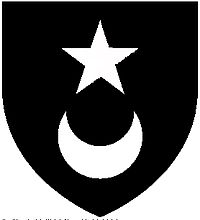Earl Fortescue is a title in the Peerage of Great Britain that was created in 1789 for Hugh Fortescue, 3rd Baron Fortescue (1753–1841), a member of parliament for Beaumaris and Lord-Lieutenant of Devon.
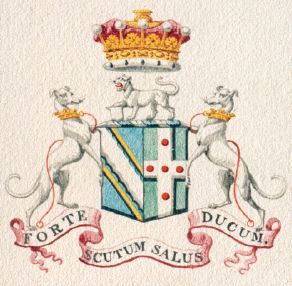
Hugh Fortescue, 1st Earl Fortescue was a British peer, created Earl Fortescue in 1789.

Hugh William Fortescue, 5th Earl Fortescue,, styled Viscount Ebrington from 1905 until 1932, of Castle Hill in the parish of Filleigh, of Weare Giffard Hall, both in Devon and of Ebrington Manor in Gloucestershire, was a British peer, military officer, and Conservative politician.
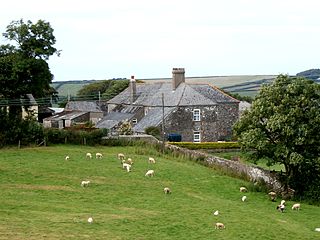
Halsbury is a historic manor in the parish of Parkham in North Devon, England. It is situated 2 miles north-east of the village of Parkham and 4 miles south-west of the town of Bideford. Halsbury was long a seat of the ancient Giffard family, a distant descendant of which was the celebrated lawyer Hardinge Stanley Giffard, 1st Earl of Halsbury (1823–1921), who adopted the name Halsbury for his earldom and was the author of the essential legal reference books Halsbury's Statutes. Halsbury Barton, now a farmhouse, retains 16th- and 17th-century elements of the former manor house of the Giffard family. It was described in a record of 1560 as a "new dwelling house".

Filleigh is a small village, civil parish and former manor in North Devon, on the southern edge of Exmoor, 3.5 miles (5.6 km) west of South Molton. The village centre's street was, until the 1980s opening of the North Devon Link Road, the main highway between the North Devon administrative centre of Barnstaple and South Molton, leading westwards to Taunton. Much of the village's land is contained within grade I listed park and garden, Castle Hill, which straddles both sides of the Link Road providing a glimpse of some of it.
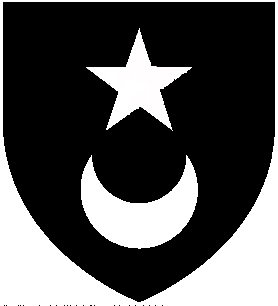
John Denzel held large estates in Cornwall and became serjeant-at-law and Attorney-General to the Queen Consort, Elizabeth of York. He had at least two daughters who became his co-heiresses, of whom Ann married Sir William Holles (1509–91) who became Lord Mayor of London. Another daughter married into the Roskymer family.
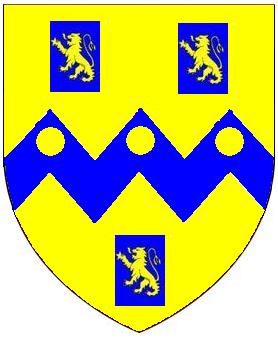
Sir Samuel Rolle of Heanton Satchville in the parish of Petrockstowe, Devon, served as Member of Parliament for Callington, Cornwall in 1640 and for Devon 1641–1647. He supported the parliamentary side in the Civil War.

Tapeley is a historic estate in the parish of Westleigh in North Devon, England.

George Horner of Mells Manor in Somerset, was an English politician who sat in the House of Commons between 1685 and 1689.

Richard Fortescue of Filleigh, North Devon was an English Member of Parliament and prominent land-owner and member of the Devonshire gentry, ancestor to the Earls Fortescue.

Sir John Chichester (1519/20-1569) of Raleigh in the parish of Pilton, near Barnstaple in North Devon, was a leading member of the Devonshire gentry, a naval captain, and ardent Protestant who served as Sheriff of Devon in 1550-1551, and as Knight of the Shire for Devon in 1547, April 1554, and 1563, and as Member of Parliament for Barnstaple in 1559, over which borough his lordship of the manor of Raleigh, Pilton had considerable influence.
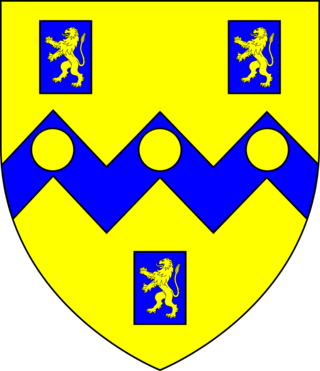
Samuel Rolle (1669-1735) of Hudscott, Chittlehampton, Devon, was MP for Barnstaple between 1705 and 1708. He was a member of a cadet branch of the influential Rolle family of Stevenstone.

Heanton Satchville was a historic manor in the parish of Petrockstowe, North Devon, England. With origins in the Domesday manor of Hantone, it was first recorded as belonging to the Yeo family in the mid-14th century and was then owned successively by the Rolle, Walpole and Trefusis families. The mansion house was destroyed by fire in 1795. In 1812 Lord Clinton purchased the manor and mansion of nearby Huish, renamed it Heanton Satchville, and made it his seat. The nearly-forgotten house was featured in the 2005 edition of Rosemary Lauder's "Vanished Houses of North Devon". A farmhouse now occupies the former stable block with a large tractor shed where the house once stood. The political power-base of the Rolle family of Heanton Satchville was the pocket borough seat of Callington in Cornwall, acquired in 1601 when Robert Rolle purchased the manor of Callington.
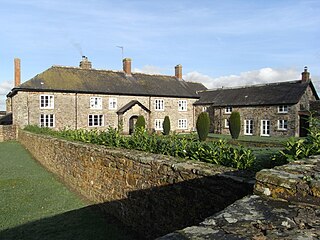
Brightley was historically the principal secondary estate within the parish and former manor of Chittlehampton in the county of Devon, England, situated about 2 1/4 miles south-west of the church and on a hillside above the River Taw. From the early 16th century to 1715 it was the seat of the Giffard family, whose mansion house occupied the moated site immediately to the west of the present large farmhouse known as Brightley Barton, a Grade II listed building which incorporates some elements of the earlier house. It is not to be confused with the 12th-century Brightley Priory near Okehampton.

Colonel John Giffard (1602–1665), of Brightley in the parish of Chittlehampton, Devon, England, was a Royalist leader during the Civil War. Giffard commanded the Devon Pikemen at the Battle of Lansdowne in 1643, in which his 3rd cousin the Royalist commander of the Cornish forces Sir Bevil Grenville (1596-1643) was killed in heroic circumstances. Giffard's loyalty to the Royalist cause led to him being proposed in 1660 as a knight of the intended Order of the Royal Oak. He was personally known to the biographer John Prince (1643–1723) who included him as one of his Worthies of Devon. He was buried in Chittlehampton Church, where his small kneeling effigy survives on the base of the monument he erected in 1625 to his grandfather.

Hudscott is a historic estate within the parish and former manor of Chittlehampton, Devon. From 1700 it became a seat of a junior branch of the influential Rolle family of Heanton Satchville, Petrockstowe and in 1779 became a secondary seat of the senior Rolle family of Stevenstone, then the largest landowner in Devon. Hudscott House, classified in 1967 a Grade II* listed building, is situated one mile south-east of the village of Chittlehampton. It was largely rebuilt in the 17th century by the Lovering family and in the late 17th century became a refuge for ejected Presbyterial ministers. In 1737 its then occupant Samuel II Rolle (1703-1747) purchased the manor of Chittlehampton and thus Hudscott House became in effect the manor house of Chittlehampton.
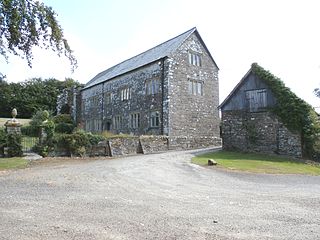
Bremridge is a historic estate within the former hundred of South Molton in Devon, England. It is now within the parish of Filleigh but was formerly in that of South Molton. It is situated 8 miles north-west of South Molton. Since the construction of the nearby A361 North Devon Link Road direct access has been cut off from Bremridge to Filleigh and South Molton. The surviving wing of the mansion house built in 1654 is a Grade II* listed building. Bremridge Wood is the site of an Iron Age enclosure or hill fort, the earthwork of which is situated on a hillside forming a promontory above the River Bray. In Bremridge Wood survives a disused tunnel of the former Great Western Railway line between South Molton and Barnstaple, much of the course of which has been used for the A361. The tunnel is 319 yards long and was identified as "Bremridge Tunnel" in the 1889 Ordnance Survey map but as "Castle Hill Tunnel" in subsequent editions.

Whympston in the parish of Modbury in Devon, England, was a historic manor that belonged to the Fortescue family.
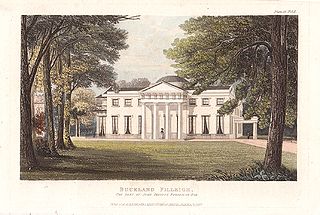
The manor of Buckland Filleigh was a manor in the parish of Buckland Filleigh in North Devon, England. Mentioned in the Domesday Book, the manor and its estates passed through several families, including over 300 years owned by the Fortescues.
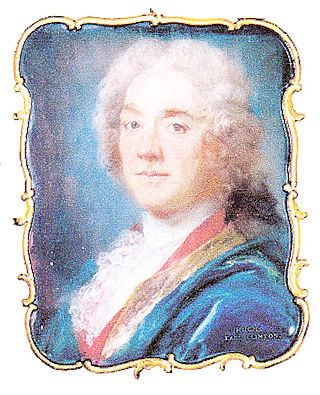
Hugh Fortescue, 1st Earl Clinton was an English peer and landowner. He built the Palladian English country house of Castle Hill, which survives to this day.







